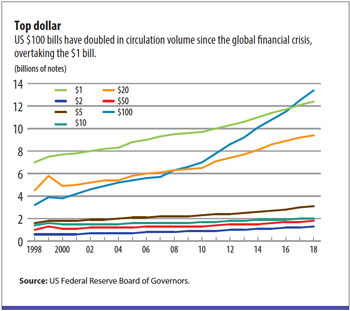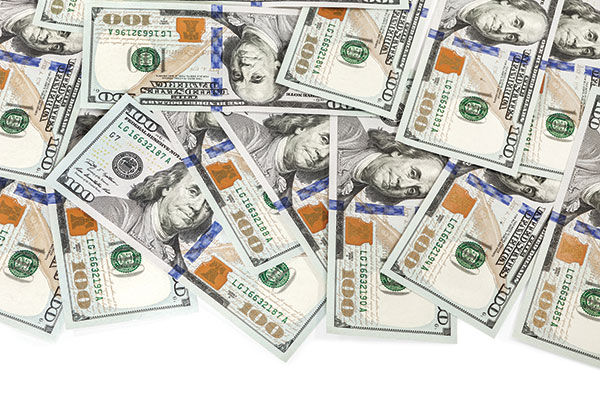What makes the US$100 bill so popular?
A CURIOUS thing recently happened in US currency: in 2017 the $100 bill overtook the ubiquitous $1 bill in circulation volume, for the first time in history. In other words, the most valuable US banknote became the most widely circulated. (The $20 bill is in third place.)

According to the Federal Reserve, there are more $100 bills circulating now than ever before, roughly doubling in volume since the global financial crisis (see chart).
So what explains this boom in Benjamins, as the bills are known, especially when cashless options are increasing by the day? In this age of Venmo transfers and digital everything, are Americans suddenly growing nostalgic for greenbacks in high denominations?
Not exactly. While overall demand for US currency is indeed on the rise, with $100 bills outpacing other denominations in both volume and total value, most $100 bills are held abroad. According to the Federal Reserve Bank of Chicago, nearly 80 percent of $100 bills—and more than 60 percent of all US bills—are overseas, up from roughly 30 percent in 1980. In fact, the average American keeps only about $60 in cash on hand (Federal Reserve Bank of Atlanta 2018).
Safe havens
Geopolitical instability could be one reason behind the surge in $100 bills, according to Fed economist Ruth Judson. “Overseas demand for US dollars is likely driven by its status as a safe asset,” Judson told the Richmond Fed’s Econ Focus in 2018. “Cash demand, especially from other countries, increases in times of political and financial crisis.”
And the world has hardly seen a shortage of crises in recent years.
According to a 2017 paper by Judson, international demand for US dollars increased over the 1990s and into the early 2000s, and then stabilized or declined after the 2002 debut of the cash euro. This decline in demand continued until late 2008, when the global financial crisis triggered renewed demand for US banknotes.
Where exactly the $100 bills are these days is impossible to know for sure. Whether it’s a conflict or refugee crisis in the Middle East or turmoil in Venezuela, it’s easy to imagine the importance of cash—particularly high-value, globally accepted currency—in unstable regions. Distrust of local currency is also thought to be a contributing factor.
Underground economics
There are, of course, other plausible explanations for this phenomenon.
IMF Assistant General Counsel Nadim Kyriakos-Saad is an expert on international anti-money-laundering efforts. “The underground economy, the informal economy, the criminal economy—all of it contributes certainly to the appeal of large denomination bills.” With increasing digitalization of payment systems in recent years, Kyriakos-Saad says, concerns about traceability could be a factor. But it’s incorrect to always associate cash with corruption, he says. “There’s this lingering desire for privacy, and desire for anonymity, which can be entirely legitimate.”
And this anonymity is precisely what makes cash usage patterns so challenging to understand.
Harvard University economics professor and former IMF Chief Economist Kenneth Rogoff says illicit activity and big banknotes are closely linked. “Worldwide, high-value currency notes are mainly used to avoid taxes and regulation, and for illegal activity,” he says. “Apartments and houses in major cities all over the world are paid for with suitcases of cash every day, and it is not because the buyers are afraid of bank failures.”
Rogoff adds that there may be another factor at play: “Underground demand for paper currency has been surely rising in part because interest rates and inflation are exceptionally low.”
But why the dollar? Other countries have currencies used abroad. “We think that the significance of foreign demand is unique to the dollar,” Judson said. “Other currencies are also used outside their home countries, but as far as we can tell, the dollar has the largest share of notes held outside the country.”
The dollar’s role as the dominant international reserve currency may be the key, according to Rogoff. “The dollar is now the only global currency; the euro has stalled, and the renminbi is decades away from challenging,” he says.
No sign of waning
Some prominent economists, including Rogoff and former US Treasury Secretary Lawrence Summers, have advocated phasing out high-denomination paper currency to discourage tax evasion and other forms of corruption. India and euro area countries have done just that in recent years: the Reserve Bank of India withdrew the 500 and 1,000 rupee bills from circulation and stripped them of their status as legal tender in 2016, with disruptive effects, while the European Central Bank stopped producing and issuing the 500 euro note in early 2019.
However, there are no signs that Benjamins are on their way out. Reasons for keeping the $100 bill include the expense of replacing them with a higher volume of $50s, possible economic repercussions of such an action, and the inevitable reduction in seigniorage—the profits a government makes from issuing currency. (A $100 bill costs the government 14 cents to produce, resulting in a tidy profit; Rogoff argues that any losses would be offset by decreased tax evasion and crime.)
One wonders what Benjamin Franklin might make of all this. The US Founding Father, who famously advised that “a penny saved is a penny earned,” is now not only the face of his country’s most valuable banknote, but possibly of the world’s most in-demand paper currency. And despite great technological strides in digital payment systems, the popularity of his bills shows no sign of waning.
Opinions expressed in articles and other materials are those of the authors; they do not necessarily reflect IMF policy.
References:
Haasl, Thomas, Sam Schulhofer-Wohl, and Anna Paulson. 2018. “Understanding the Demand for Currency at Home and Abroad.” Chicago Fed Letter 396, Federal Reserve Bank of Chicago, Chicago, IL.
Judson, Ruth. 2017. “The Death of Cash? Not So Fast: Demand for U.S. Currency at Home and Abroad, 1990–2016.” Board of Governors of the Federal Reserve System, Washington, DC.
Rogoff, Kenneth. 2016. The Curse of Cash. Princeton, NJ: Princeton University Press.
Sablik, Tim. 2018. “ Is Cash Still King?” Econ Focus, Federal Reserve Bank of Richmond, Richmond, VA.










